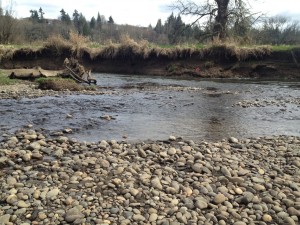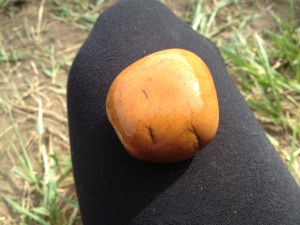
My cosmology is in flux like the rest of me. I’ve done the strident Christian thing. I’ve defied the entire Christian paradigm with the Hebrew roots thing. I’ve got lots of big words and the ability to do great damage with them, and I have spent a wee bit of time being a complete Ass Hat about my fluctuating beliefs.
Throughout this breakdown Spiritual Awakening, I’ve been ignoring a categorical definition of my belief system for a couple of good reasons, most notably that I’m not sure I can put it into words yet and if I could, I’m not sure anyone else would understand what I was getting at. Or feel comfortable with what I was getting at. These are Spirit things, and they defy attempts to contain them.
Today, I’m good to call that which is bigger than I am Abba (Father); YHVH (I am that I am which I take to mean ‘I’m here so get over it’); the Creator, Source, and maybe Ein Sof. Happy Wikipedia-ing.
My big thing is: be intellectually honest. Easter is pagan. If you’re a Christian, no amount of revisionist history can make it not be so. If you are a pagan, Happy Spring. If you feel led to look into a tradition that honors the Biblical Messiah’s victory over death, real or mythological, look into Passover. If you want to celebrate spring with milk-based foods and egg-shaped candy, good idea. It’s been cold and dark this winter, and three cheers for what Wonka has done with the jelly bean. I guess that’s what’s hard for me where I am. I know what all the sides are called, but I’m not sure how I want to identify.
I like the earth based components of Biblical Hebrew traditions. Not the ‘new’ Jewish traditions like the Passover Chicken and the seder plate egg. But the blowing of the shofar on the New Moon to reckon the new month and to call home the tribes; the counting of the omer the culmination of which is a meal offering of the harvest fruits symbolizing the giving of the spiritual wisdom (in this case, Torah) as food for human Souls; and especially the feast of Sukkot (Booths), during which we essentially make blanket forts out of tree boughs and spend time outside contemplating the transience of this go-round and doing whatever our hearts desire up to and including strong drink. A year off every seven to let the earth rest and recoup? If you could take the Bible out of them, Hebrew festivals are a pagan’s dream!
These celebrations are meaningful to me.
Another beautiful tradition that resonates deeply with me is called tashlich. It is Hebrew for ‘casting off’ and is based on the section in Micah where the prophet talks about YHVH casting the sins of the people into the depths of the sea. Westerners think of ‘sins’ as pathological moral blight. It’s not so in Hebrew where a ‘sin’ is a short-coming, a wounding — an area that lacks completeness and maturity, that hurts and leads us to do things not in our highest good. In Hebrew thought, sins don’t require pitchforks and crowd control, but rather healing. I can list off at least a handful of my wounded and immature areas without breaking a sweat.
Traditionally during tashlich, people go to rivers and streams and toss in bits of bread which represent their ‘sins’. There is catharsis as the water carries these crumbs away.
That’s the tradition. But I’m in flux, so here’s how I did it. Quite by accident.
I went for a walk early one day this week along Salmon Creek. (Tashlich is a fall tradition. As I write this, it’s Day Two of Spring). I didn’t turn on my ipod, and instead listened to birds’ tweets and Salmon Creek’s gurgles. A stray siren, some airplanes on their flight paths. I nodded to the work crew trimming the mahonia and walked purposefully and eyes engaged in case they were sexual predators on work release. Once out of view of the work crew, I meandered uphill and got my inner hippy on by standing in the vortex between two huge evergreens, feeling my feet grounded into the earth between them, putting my palms out to touch them both, imagining my life rooted here and now. I was quiet there awhile.
Trees are what & where they are; people come to them or don’t. They don’t fritter much. Trees just stand there and be themselves.
This was going well.
As I descended from that part of the path, I came to the place where my family used to go to do tashlich — back when we were a family. Grounded from my tree vortex, I knelt by the water. I use rocks when I do tashlich. (In the Pacific Northwest, we don’t throw food in our water.) I picked up a pebble.
“Not trusting that I have all I need,” I said out loud as I tossed it into the water.
“Using my dislike of people as an excuse to pull away from you.” And another:
“Getting stuck in a story of the past instead of boldly doing the creative work you have put inside me.” And another:
“Being mad at myself for taking so long in the cocoon.”
From places where we aren’t judged for the puss, it feels good to get all of it out.
“Letting what I think other people might think get in the way of being true to myself.” And another:
“Fear that I will succeed and then implode mightily.” And another:
“Not letting myself engage because I might get hurt.” And another:
Well, you get the picture. And as I picked rocks the size that fit the relative importance of these extraneous characters in my story, insight came. Letting go feels powerful and brave. I am ready to start taking action steps to live my new story. Action. It is time to surrender — let go of the outcome. The next step will appear. I’m not alone. I have support. It is safe to move forward.
I had been eye-balling a really pretty, larger yellow rock nestled in the sand. I picked it up and rinsed it off in the water. It was more beautiful wet as rocks are. “What do I want to take away from this? What words capture this peace I have inside me right now?” I asked myself…
I named the rock “Surrender” and “Action” and “Abundant Flow”*. (It splits home between my purse and my monitor stand.) I went home and registered a domain name for my writing business and today I signed up for a New Media Journalism Master’s Program.
2013: Best. Tashlich. Ever.

